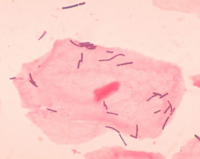Lactobacillus acidophilus: Difference between revisions
imported>Omar Qureshi No edit summary |
imported>Omar Qureshi No edit summary |
||
| Line 20: | Line 20: | ||
==Description and significance== | ==Description and significance== | ||
''Lactobacillus acidophilus'' is a species of gram-positive bacteria commonly used in dairy production. ''L. acidophilus'' is also one of the most common forms of probiotics, which are "friendly bacteria". ''L. acidophilus'' is found in the human and animal gut, mouth, and vagina. It functions as a lactic acid producer, by metabolizing lactose to lactic acid. The acid produced by ''L. acidophilus'' can control the growth of the fungus ''Candida albicans'', which is the cause of Oral thrush, vaginal yeast infections, and the presence of unwanted organisms living in the gut. Common dairy products which use ''L. acidophilus'' in their production include Sweet acidophilus milk and yogurt. Sweet acidophilus milk and yogurt can be consumed by those who are lactose intolerant, since ''L. acidophilus'' can aid in the metabolism of lactose to lactic acid. | ''Lactobacillus acidophilus'' is a species of gram-positive bacteria commonly used in dairy production. ''L. acidophilus'' is also one of the most common forms of probiotics, which are "friendly bacteria".<ref>http://www.umm.edu/altmed/articles/lactobacillus-acidophilus-000310.htm</ref> ''L. acidophilus'' is found in the human and animal gut, mouth, and vagina. It functions as a lactic acid producer, by metabolizing lactose to lactic acid. The acid produced by ''L. acidophilus'' can control the growth of the fungus ''Candida albicans'', which is the cause of Oral thrush, vaginal yeast infections, and the presence of unwanted organisms living in the gut. Common dairy products which use ''L. acidophilus'' in their production include Sweet acidophilus milk and yogurt. Sweet acidophilus milk and yogurt can be consumed by those who are lactose intolerant, since ''L. acidophilus'' can aid in the metabolism of lactose to lactic acid. | ||
==Genome structure== | ==Genome structure== | ||
Revision as of 19:50, 21 April 2009
For the course duration, the article is closed to outside editing. Of course you can always leave comments on the discussion page. The anticipated date of course completion is May 21, 2009. One month after that date at the latest, this notice shall be removed. Besides, many other Citizendium articles welcome your collaboration! |
| Lactobacillus acidophilus | ||||||||||||||
|---|---|---|---|---|---|---|---|---|---|---|---|---|---|---|
 | ||||||||||||||
| Scientific classification | ||||||||||||||
| ||||||||||||||
| Binomial name | ||||||||||||||
| Lactobacillus acidophilus |
Description and significance
Lactobacillus acidophilus is a species of gram-positive bacteria commonly used in dairy production. L. acidophilus is also one of the most common forms of probiotics, which are "friendly bacteria".[1] L. acidophilus is found in the human and animal gut, mouth, and vagina. It functions as a lactic acid producer, by metabolizing lactose to lactic acid. The acid produced by L. acidophilus can control the growth of the fungus Candida albicans, which is the cause of Oral thrush, vaginal yeast infections, and the presence of unwanted organisms living in the gut. Common dairy products which use L. acidophilus in their production include Sweet acidophilus milk and yogurt. Sweet acidophilus milk and yogurt can be consumed by those who are lactose intolerant, since L. acidophilus can aid in the metabolism of lactose to lactic acid.